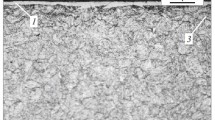Abstract
We analyze the results of using the partial pressure of nitrogen, thermokinetic parameters of saturation, elements of vacuum technology (vacuum annealing, heating in vacuum), and the initial structure and texture of material as factors for the intensification of nitriding in molecular nitrogen. We show that the processes of nitride formation and gas saturation are activated both by thermocycling and an increase in the temperature of isothermal soaking. When the partial pressure of nitrogen decreases, the nitride formation is retarded, but the gas saturation is accelerated. A similar effect is observed if one uses elements of vacuum technology. Conditions of high-speed heating make it possible to activate the nitride formation by inhibiting the appearance of the zone of α-solid solution of nitrogen in titanium.
Similar content being viewed by others
References
H. H. Maksymovych, V. M. Fedirko, and I. M. Pohrelyuk, “Kinetic laws of the interaction between titanium alloys and nitrogen,”Fiz.-Khim. Mekh. Mater.,24, No. 6, 77–81 (1988).
R. J. Wasilewski and I. Kehl, “Diffusion of nitrogen and oxygen in titanium,”J. Inst. Metals,55, No. 83, 94–104 (1954).
S. S. Kiparisov and Yu. V. Levinskii,Nitriding of Refractory Metals [in Russian], Metallurgiya, Moscow (1972).
H. H. Maksymovych, V. M. Fedirko, and I. M. Pohrelyuk, “A mechanism of formation of near-surface hardened layers on titanium alloys in a rarefied dynamic atmosphere of nitrogen,”Fiz.-Khim. Mekh. Mater.,27, No. 2, 38–42 (1991).
E. N. Novikova, “Nitriding of titanium alloys under reduced pressures,” in:Physical Metallurgy of Titanium [in Russian], Nauka Moscow (1964), pp. 132–138.
V. M. Fedirko and I. M. Pohrelyuk, “Increase in wear resistance of titanium alloys by chemical heat treatment in nitrogen-containing media,”Fiz.-Khim. Mekh. Mater.,30, No. 1, 69–74 (1994).
S. Shen and C. Tan, “The development of a new process for PS-P fast gas nitriding,” in:Heat Treat. and Technol. Surface Coat.: New Process and Appl. Exper.: Proc. 7th Int. Congr. Heat Treat. Mater. (Moscow, Dec. 11–14, 1990), Vol. 1 (1990), pp. 162–168.
M. N. Bodyako, A. A. Shipko, and E. M. Belyaeva, “Role of the initial structure in the course of nitriding of VT6 alloy at high-speed heating,”Vestsi Akad. Navuk BelSSR, Ser. Fiz.-Tekhn. Navuk, No.3, 23–26 (1987).
M. N. Bodyako, A. A. Shipko, and E. M. Nikolaichik, “Influence of the heating rate on the structure and properties of the nitrided layer of VT9 alloy,”Vestsi Akad. Navuk BSSR, Ser. Fiz.-Tekhn. Navuk, No. 1, 26–28 (1983).
I. M. Pohrelyuk, “Surface hardening of titanium during thermocycling in nitrogen”,Fiz.-Khim. Mekh. Mater.,33 No. 6, 39–43, (1997).
O. H. Luk'yanenko, V. S. Pavlyna, A. T. Pichugin et al., “Influence of thermocycling on the high-temperature interaction between titanium and gases,”Fiz.-Khim. Mekh. Mater.,33, No. 6, 7–14 (1997).
O. P. Solonina and S. G. Glazunov,Refractory Titanium Alloys [in Russian], Metallurgiya, Moscow (1976).
I. S. Kulikov,Thermal Dissociation of Compounds [in Russian], Metallurgiya, Moscow (1969).
H. H. Maksymovych, V. M. Fedirko, Ya. I. Spektor et al.,Heat Treatment of Titanium and Aluminum Alloys in Vacuum and Inert Media [in Russian], Naukova Dumka, Kiev (1987).
M. N. Podoprikhin, V. V. Peshkov, E. S. Vorontsov et al., “Study of oxidation of titanium under reduced pressure of air by the method of interference indication”Zh. Fiz. Khim.,55, No. 10, 2663–2665 (1981).
M. V. Maltsev,Heat Treatment of Refractory and Rare Metals and Their Alloys [in Russian], Metallurgiya, Moscow (1974).
O. H. Luk'yanenko, H. H. Maksymovych, V. S. Pavlyna, and A. T. Pichugin “Peculiarities of the diffusive dissolution of oxide films on titanium under conditions of thermocycling,”Fiz.-Khim. Mekh. Mater.,34, No. 1, 78–82 (1998).
S. Z. Bokshtein,Structure and Properties of Metal Alloys [in Russian], Metallurgiya, Moscow (1971).
D. A. Prokoshkin, E. V. Vasil'eva, V. I. Tret'yakov et al. “Influence of structure defects on diffusion of nitrogen in niobium and its alloys,”Izv. Akad. Nauk SSSR, Metally, No. 5, 166–172 (1975).
T. A. Panaioti, “Surface and bulk nitriding of refractory metals and their alloys,” in:Proc. N. É. Bauman Moscow Higher Engng. School [in Russian], No. 497 (1987), pp. 25–37.
V. A. Bogomolov and A. A. Govorov, “Influence of the structure of titanium alloy VT3-1 on the character of diffusion on nitriding,”Metalloved. Term Obrab. Met., No. 9, 60–61 (1971).
R. A. Adamesku, P. V. Gel'd, and E. A. Mityushov,Anisotropy of Physical Properties of Metals [in Russian], Metallurgiya Moscow (1985).
Additional information
Karpenko Physicomechanical Institute, Ukrainian Academy of Sciences, L'viv. Translated from Fizyko-Khimichna Mekhanika Materialiv, Vol. 35, No. 1, pp. 61–70, January–February, 1999.
Rights and permissions
About this article
Cite this article
Pohrelyuk, I.M. Ways of intensification of thermodiffusive saturation of titanium alloys in molecular nitrogen. Mater Sci 35, 66–75 (1999). https://doi.org/10.1007/BF02355603
Received:
Issue Date:
DOI: https://doi.org/10.1007/BF02355603




